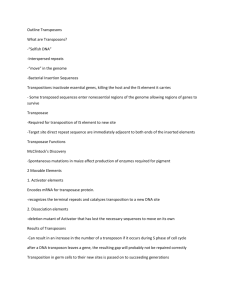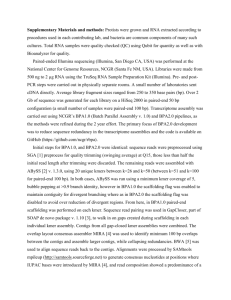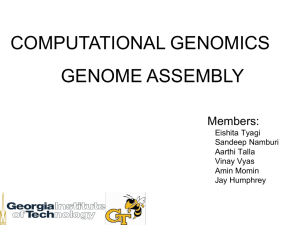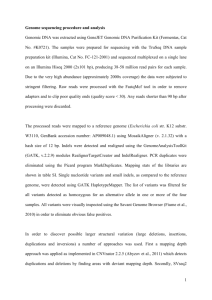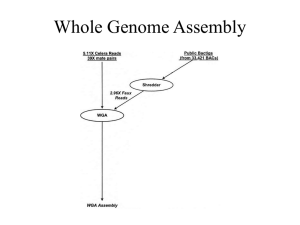Supplementary Materials & Methods
advertisement
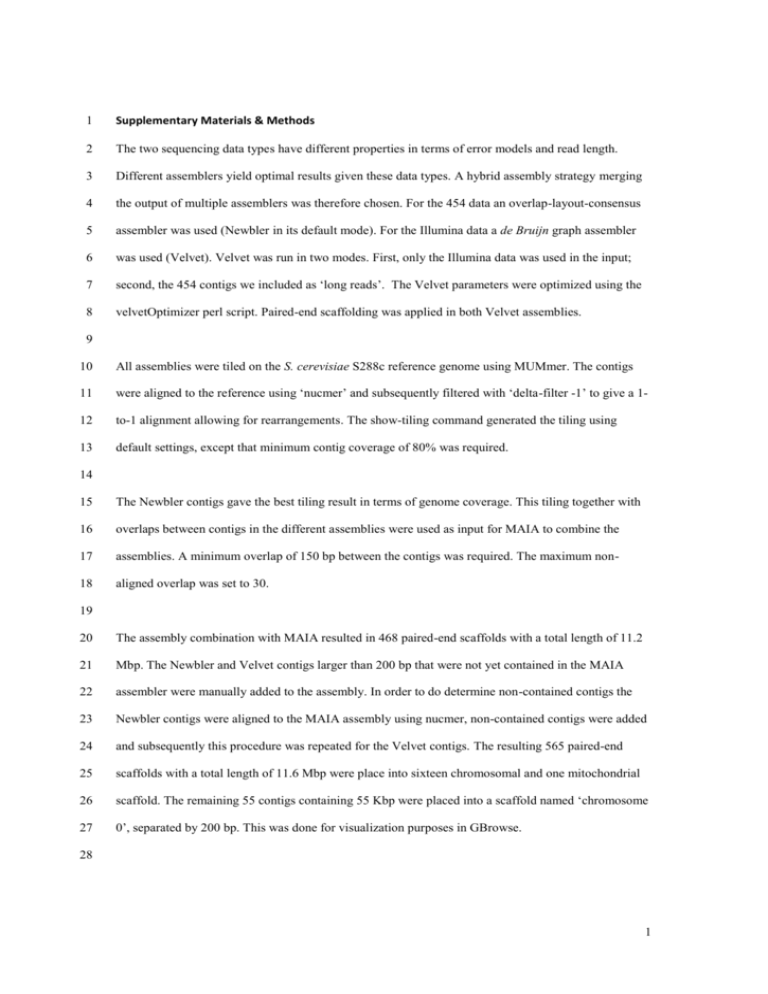
1 Supplementary Materials & Methods 2 The two sequencing data types have different properties in terms of error models and read length. 3 Different assemblers yield optimal results given these data types. A hybrid assembly strategy merging 4 the output of multiple assemblers was therefore chosen. For the 454 data an overlap-layout-consensus 5 assembler was used (Newbler in its default mode). For the Illumina data a de Bruijn graph assembler 6 was used (Velvet). Velvet was run in two modes. First, only the Illumina data was used in the input; 7 second, the 454 contigs we included as ‘long reads’. The Velvet parameters were optimized using the 8 velvetOptimizer perl script. Paired-end scaffolding was applied in both Velvet assemblies. 9 10 All assemblies were tiled on the S. cerevisiae S288c reference genome using MUMmer. The contigs 11 were aligned to the reference using ‘nucmer’ and subsequently filtered with ‘delta-filter -1’ to give a 1- 12 to-1 alignment allowing for rearrangements. The show-tiling command generated the tiling using 13 default settings, except that minimum contig coverage of 80% was required. 14 15 The Newbler contigs gave the best tiling result in terms of genome coverage. This tiling together with 16 overlaps between contigs in the different assemblies were used as input for MAIA to combine the 17 assemblies. A minimum overlap of 150 bp between the contigs was required. The maximum non- 18 aligned overlap was set to 30. 19 20 The assembly combination with MAIA resulted in 468 paired-end scaffolds with a total length of 11.2 21 Mbp. The Newbler and Velvet contigs larger than 200 bp that were not yet contained in the MAIA 22 assembler were manually added to the assembly. In order to do determine non-contained contigs the 23 Newbler contigs were aligned to the MAIA assembly using nucmer, non-contained contigs were added 24 and subsequently this procedure was repeated for the Velvet contigs. The resulting 565 paired-end 25 scaffolds with a total length of 11.6 Mbp were place into sixteen chromosomal and one mitochondrial 26 scaffold. The remaining 55 contigs containing 55 Kbp were placed into a scaffold named ‘chromosome 27 0’, separated by 200 bp. This was done for visualization purposes in GBrowse. 28 1 29 The 454 data used in the assembly is known to be sensitive to homopolymer errors. These errors were 30 corrected using the k-mer correction tool (Datema et al.). After correction the assembly was annotated 31 using Cyrille2 pipeline. Genes in the CEN.PK genome were located using a combination of tools. Both 32 ab initio and comparative gene predictors were applied. The predicted gene models were combined 33 using Jigsaw [3]. The resulting annotated genome will be made available through Gbrowse [4] (Fig. 34 2). 35 36 2 37 Supplementary tables and figures 38 39 Table S1 Repetitive transposon sequences were hard to assemble from whole genome shotgun data. 40 Evidence of transposons was obtained in two ways. First, depth-of-coverage of CEN.PK and S288C 41 reads on Ty retrotransposons sequences in the S288C genome was analysed. Log 2-ratio's were 42 calculated using CNV-seq (Xie & Tammi, 2009). The number of retrotransposons was estimated from 43 these ratios. Second, evidence for transposons in the assembly was obtained by counting the presence 44 of contig breaks (CB) on transposon loci in S288C and the presence of assembled (AS) transposons 45 (Figure S1). An assembled transposon locus with a gapped alignment (GA) around the transposon 46 sequence in S288C indicates the transposon is absent from the CEN.PK genome. 47 48 Table S2 (Excel file) SNVs in genes in CEN.PK compared to S288c found by aligning the CEN.PK assembled 49 genome to the S288c reference genome with MUMmer (Kurtz, et al., 2004). 50 51 Table S3 (Excel file) Indels in genes in CEN.PK compared to S288c found by aligning the CEN.PK assembled 52 genome to the S288c reference genome with MUMmer (Delcher, et al., 2002) (Kurtz, et al., 2004). 53 54 Table S4 (Excel file) Mutations in the galactose uptake and ergosterol biosynthesis pathways 55 compared to the SNVs found previously in CEN.PK Otero et al (2010). 56 Table S5 Mutations found in genes in the cAMP signaling pathway. The genes that were considered to be part of 57 the cAMP signaling pathway are listed in Figure 2. 58 59 Table S6 (Excel file) List of deleted genes, which is defined as not having a homologous hit in the CEN.PK 60 genome for at least 95% and having a CEN.PK/S288c log2 ratio of less then -0.6. The PMR2 locus has a blue 61 background color. 62 63 Table S7 S. cerevisiae with an assembled genome deposited in GenBank. The classification assigned in 64 the ‘group’ column was used to generate Figure 8. 65 66 Table S8 Primer used in this study. 67 3 68 Figure S1 Analysis of transposon composition by alignment of the CEN.PK and S288c genomes. 69 When an S288c transposon is not present in CEN.PK it results in a gapped alignment (GA) of about 6 70 Kbp. Transposons that are present can cause contig breaks (CB) in the assembly. Only YCLWTy5-1 71 was fully assembled (AS). 72 73 Figure S2 Chromosome separation gel with RDL1 and PHO12 probed. 74 75 Figure S3 Chromosome separation gel with Contig00483 probed. 76 77 Figure S4 Differences between CEN.PK and S288c in the MAPK signaling pathway. 78 79 References supplemental material 80 Delcher AL, Phillippy A, Carlton J & Salzberg SL (2002) Fast algorithms for large-scale genome 81 alignment and comparison. Nucleic acids research 30: 2478-2483. 82 Kurtz S, Phillippy A, Delcher AL, Smoot M, Shumway M, Antonescu C & Salzberg SL (2004) 83 Versatile and open software for comparing large genomes. Genome biology 5: R12. 84 Xie C & Tammi MT (2009) CNV-seq, a new method to detect copy number variation using high- 85 throughput sequencing. BMC bioinformatics 10: 80. 86 87 4

